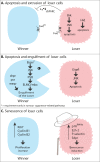Cell wars: regulation of cell survival and proliferation by cell competition
- PMID: 22928509
- PMCID: PMC3707360
- DOI: 10.1042/bse0530069
Cell wars: regulation of cell survival and proliferation by cell competition
Abstract
During cell competition fitter cells take over the tissue at the expense of viable, but less fit, cells, which are eliminated by induction of apoptosis or senescence. This probably acts as a quality-control mechanism to eliminate suboptimal cells and safeguard organ function. Several experimental conditions have been shown to trigger cell competition, including differential levels in ribosomal activity or in signalling pathway activation between cells, although it is unclear how those differences are sensed and translated into fitness levels. Many of the pathways implicated in cell competition have been previously linked with cancer, and this has led to the hypothesis that cell competition could play a role in tumour formation. Cell competition could be co-opted by cancer cells to kill surrounding normal cells and boost their own tissue colonization. However, in some cases, cell competition could have a tumour suppressor role, as cells harbouring mutations in a subset of tumour suppressor genes are killed by wild-type cells. Originally described in developing epithelia, competitive interactions have also been observed in some stem cell niches, where they play a role in regulating stem cell selection, maintenance and tissue repopulation. Thus competitive interactions could be relevant to the maintenance of tissue fitness and have a protective role against aging.
Figures


References
-
- Morata G., Ripoll P. Minutes: mutants of Drosophila autonomously affecting cell division rate. Dev. Biol. 1975;42:211–221. - PubMed
-
- Simpson P. Parameters of cell competition in the compartments of the wing disc of Drosophila. Dev. Biol. 1979;69:182–193. - PubMed
-
- Simpson P., Morata G. Differential mitotic rates and patterns of growth in compartments in the Drosophila wing. Dev. Biol. 1981;85:299–308. - PubMed
Publication types
MeSH terms
Grants and funding
LinkOut - more resources
Full Text Sources

